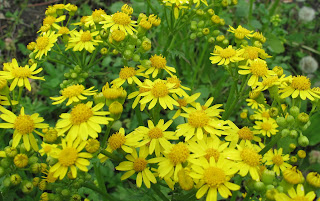ACRES Bender Memorial Forest, on the Elkhart River in Noble County, has several sections that are permanently wet, but now the entire forest is wet. Some sections of the trail are under water --- knee boots are a necessity.
 |
| Yellow Water Buttercup partially submerged |
 |
| Yellow Water Buttercup, Ranunculus flabellaris |
A large spread of Yellow Water Buttercup is blooming in the lowest section of the forest, always wet; but the water is deeper than any other time I've tramped around in it and there are more Yellow Water Buttercup than I've ever seen. Most of the leaves are submerged; the flowers stick out of the water several inches.
Tufted Loosestrife is another yellow flower blooming in the same wet environment as the Yellow Water Butercup.
 |
| Tufted Loosestrife, Lysimachia thrysiflora |
 |
| Blue Flag, Iris virginica |
Blue Flag, also growing in standing water, is just beginning to bloom. It is a native Iris.
 |
| Green Dragon, Arisaema dracontium |
Green Dragon,
Arisaema dracontium, a close cousin of Jack-in-the-Pulpit,
Arisaema triphyllum, most always grows in wet areas, although not in standing water. Both have a spathe that wraps around the spadix, but the Green Dragon's spadix sticks out 3-4 inches.
 |
| American Gromwell, Lithospremum latiflolium |
American Gromwell grows near Green Dragon at Bender Forest. Although its 1/4 inch yellow flowers are unremarkable, it is an uncommon, interesting native plant. According to the
USDA Plant Database, Noble County is the only northeastern Indiana county where it has been reported; it is on the endangered list in Pennsylvania and Maryland, but not Indiana.
Two species of Waterleaf are blooming at Bender. Both are in the low wet parts of the forest and on the well-drained slopes.
 |
| Virginia Waterleaf, Hydrophyllum virginianum |
 |
| Broad-Leaved Waterleaf, Hydrophyllum canadense |
 |
| Broad-Leaved Waterleaf up close |
American Columbo is a mysterious plant that grows on a south-facing wooded slope in Bender Forest. Each year the plant grows a whorl of large basal leaves, and occasionally if flowers about this time of year. This year none of the more than fifty plants bloomed.
 |
| American Colombo basal leaves, Frasera caroliniensis |
A variety of ferns grow at Bender; several species grow in the wettest sections, but the Maidenhair Fern grows on the well-drained slopes. Ferns reproduce by spores, rather than by flowers and seeds.
 |
| Northern Madienhair Fern, Adiatum pedatum | |
This large beetle was immobile on this cool, cloudy day.
 |
| Horse Gentian, Triosteum aurantiacum |
The Horse Gentian in the photo above is growing in an old field at the edge of the forest. The yellow flowers will develop into orange fruits in Fall.
 |
| Orange fruits of Horse Gentian |
Below please find the complete list of native wildflowers I found in bloom at Bender Forest today:
Yellow Water Buttercup,
Ranunculus flabellaris
Tufted Loosestrife,
Lysimachia thyrsiflora
Blue Flag,
Iris virginica
Green Dragon,
Arisaema dracontium
Jack-in-the-Pulpit,
Arisaema triphyllum
Virginia Waterleaf,
Hydrophyllum viriginianum
American Gromwell,
Lithospermum latifloim
Broad-Leaved Waterlead,
Hydrophyllum canadense
Orange-Fruited Horse Gentian
, Triosteum aurantiacum
May-Apple,
Podophyllum peltatum
Wild Geranium,
Geranium maculatum
Clustered Snakeroot,
Sanicula gregaria
Aniseroot,
Osmorhiza longistylis
Blue Phlox,
Phlox divaricata
Common Fleabane,
Erigeron philadelphicus
Golden Ragwort,
Packera aurea
Cream Violet,
Viola striata
False Solomon's Seal,
Maianthemum racemosum
Hairy Solomon's Seal,
Polygonatum pubescens
Wild Ginger,
Asarum canadense
Doll's Eyes,
Actaea pachypoda























































